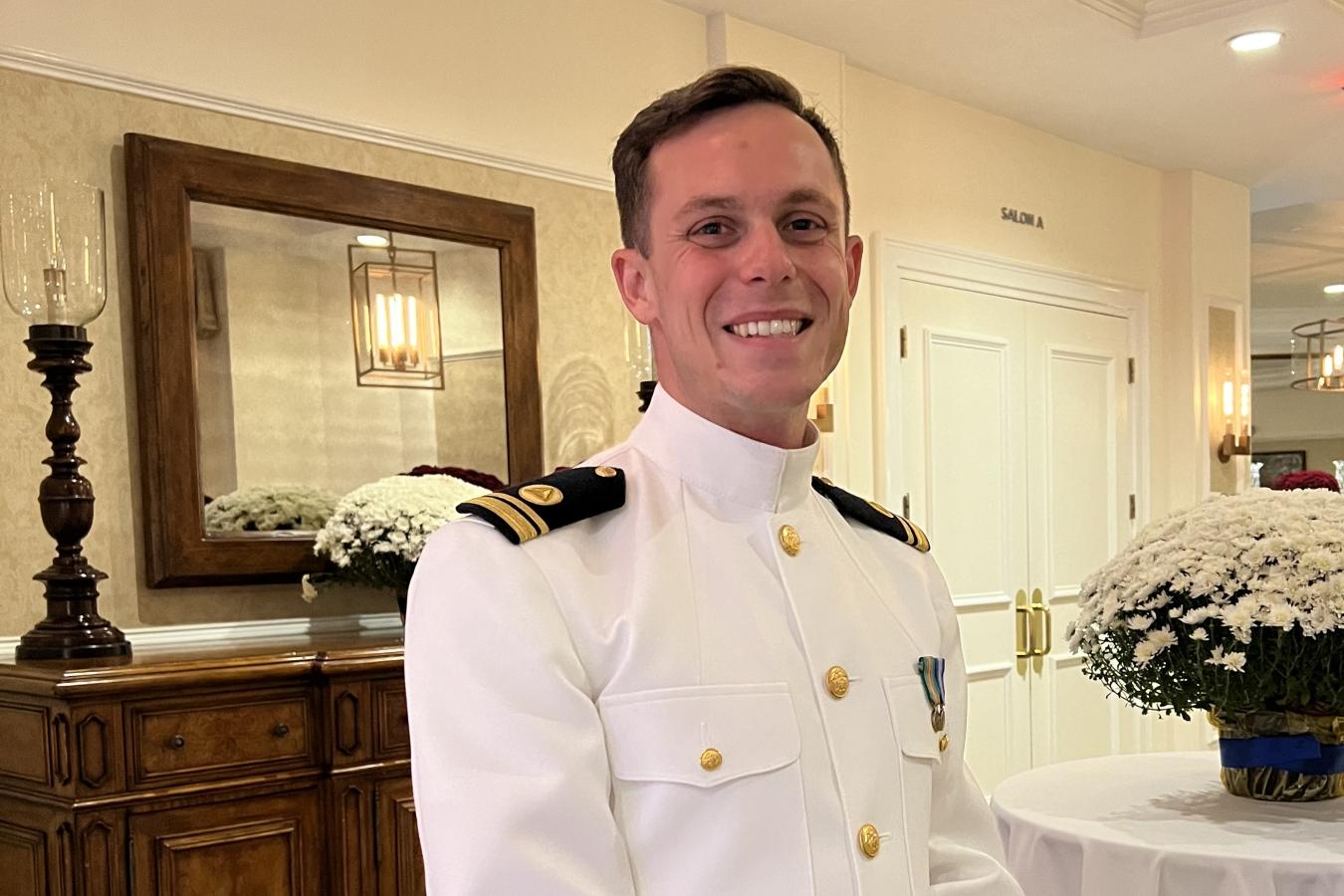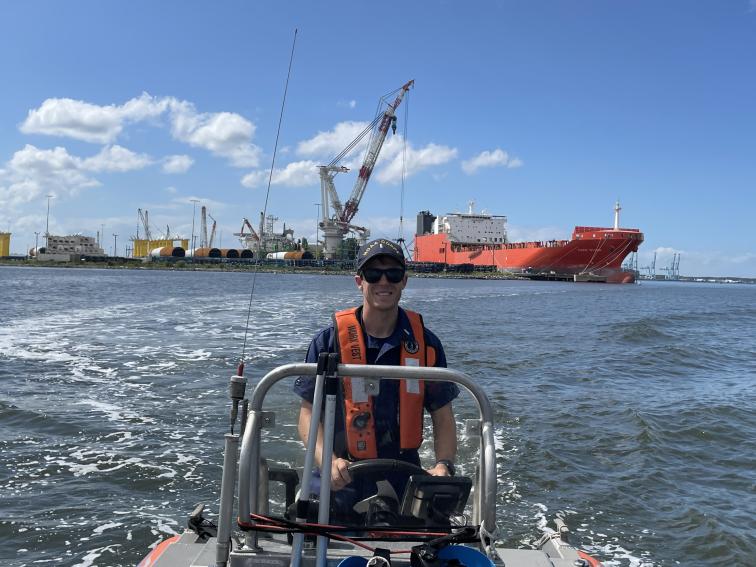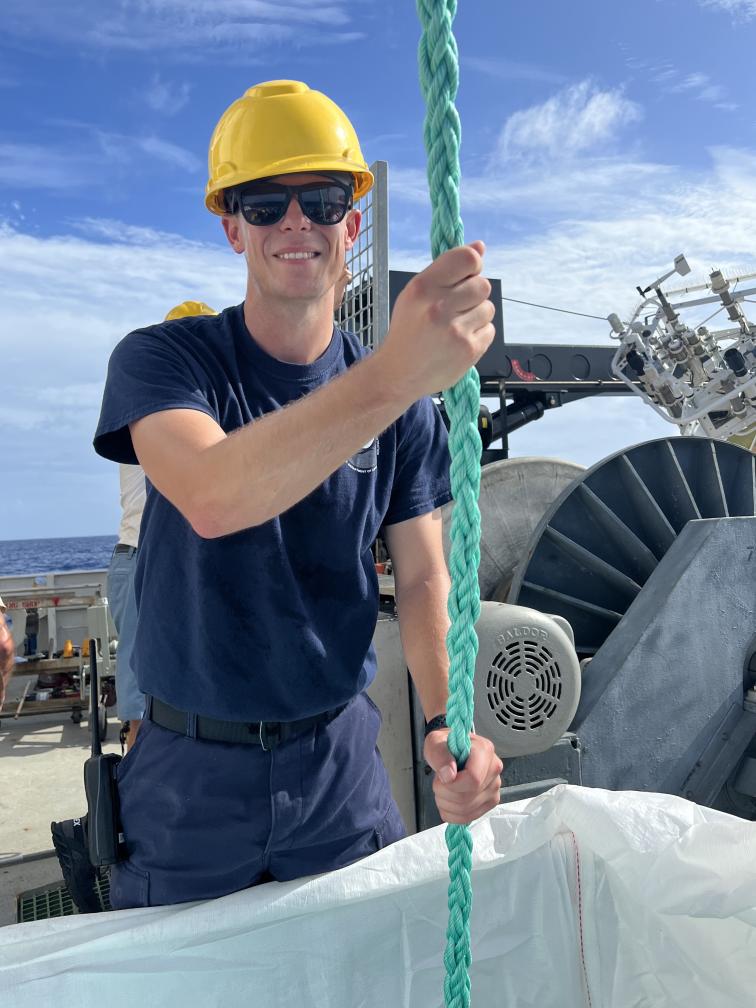
The NOAA Commissioned Officer Corps (NOAA Corps) is one of the nation’s eight uniformed services and NOAA Corps officers are an integral part of NOAA. With approximately 330 officers and growing, the NOAA Corps supports nearly all of NOAA’s programs and missions. The combination of commissioned service and scientific expertise makes these officers uniquely capable of leading some of NOAA’s most important initiatives. Meet NOAA Corps officer LTJG Tim Montera.
EDITOR'S NOTE: Soon after this story published, LTJG Montera was promoted to lieutenant.
Where did you grow up?
I grew up on the South Shore of Long Island in Bellmore, New York.
Where did you go to school and in what subject did you get your degree(s)?
When I was applying for colleges in high school I knew I wanted to work in the science field but not exactly sure how. I also knew I needed a job and a viable income, so I looked for a college that would set me up with career opportunities upon graduation. I also knew it needed to be something that I found interesting. State University of New York (SUNY) Maritime College checked both of those boxes. It offered me a path to a career in an industry I knew little about and a major in science.
I attended SUNY Maritime as a cadet in the Deck License program. I was a regimented student, which means I had a different college experience than most. We wore uniforms daily, had morning formation, room inspections and followed a set of rules. Everything had a reason even if you didn’t know it at the time.
The degree offered me insight into many different aspects of the marine sciences. My classmates and I liked to say we know a little bit about a lot of stuff. This allowed us to be marketable and work almost anywhere in the marine science field.
As a Deck License cadet I worked towards attaining my Third Mate Unlimited Tonnage License. Part of that program was to attend three Summer Sea Terms (SST) and complete license classes.
Every summer as a cadet I was on the Training Ship Empire State VI for SST, where we learned how to apply what we learned in class in real life. The cadets ran the ship with guidance from the mates and engineers. We were on deck chipping paint, in the scullery, in class and stood watch during each SST. The first two SSTs were 50 days long with the last one being a full SST at 105 days long. Each SST you gain more responsibility and gain more experience. I learned to love working on ships and sailing on the ocean to see the world.
After completing four years and three SSTs I graduated with a Bachelors of Science in Marine Environmental Science with a minor in Meteorology and Oceanography and a Third Mate Unlimited tonnage license.
What inspired you to become a NOAA Corps officer?
I happened upon the NOAA Corps in my first class (senior) year of college, when one of my instructors, Mate Matthew Germann, told me about it. He used to train the BOTC classes when they were located at the United States Merchant Marine Academy. There were a few other mates that taught me during my time at Maritime with NOAA Corps experience. They told me all the exciting missions they went on.
When looking for a job I wanted to find a way to use both my degree and license. NOAA research vessels fit that category perfectly. I would be able to drive unique research vessels and be a part of a mission that is vital to the country. Driving a NOAA ship is more fun than a cargo ship because I get to maneuver it every day rather than making a few course changes every so often. I also get to dock the ship with oversight from the Commanding Officer; another thing many of my classmates who sail deep sea don’t get to do regularly.
Then I looked at the work life balance and all the benefits that being an officer provides. I get to be assigned to a ship and complete missions on one rotation then work on shore supporting the fleet or other NOAA missions. This career path offers a lot of different experiences that I would not normally get if I sailed for 20 years in the private sector.
The change of pace every three years was and still is something that I like. Each position I gain experience and learn more about what NOAA does.
Driving research vessels was always a goal because of the missions they go on. I enable the scientists to accomplish their missions and get to see how their work gets accomplished. They also work in unique locations in the oceans where many cargo ships do not go, such as the middle of the Atlantic to work on oceanographic buoys.
My family also has a history of serving in uniformed services, and I am proud to carry on that tradition. My father served in the Coast Guard and my grandfather retired from the Army as a Colonel. My younger brother is also an officer in the Army.

What do you do as a NOAA Corps officer?
I am currently the Operations Manager at Marine Operations Center - Atlantic. I am a part of the Operations Team that consists of officers and civilians. We work with our port offices in Pascagoula, Mississippi, Newport, Rhode Island and Charleston, South Carolina to support the nine ships in the east coast fleet. This includes two ships that frequently work internationally, one of which is a global class research vessel.
One aspect of my current position is managing Project Instructions for each of our missions. These are the documents that create a contract between the mission partner and the ship. They describe the mission objectives, location, who is going, and what equipment is needed. I am the liaison between the mission partner and the ship ensuring these get completed and signed prior to the ship leaving.
My favorite part is that I get to augment, which is where I get to sail on a ship while I am on my shore assignment. I have the opportunity to see the missions on other platforms and provide relief to officers so they can take leave during the season. So far I have been able to experience buoy operations, bottom trawling, hydrographic surveying and mammal studies through augmenting on NOAA ships Ronald H. Brown, Nancy Foster, Gordon Gunter, Ferdinand R. Hassler, and Henry B. Bigelow.
My first ship was NOAA Ship Ronald H. Brown, NOAA's only global class research vessel. I was a Junior Officer there, where I became an Officer of the Deck (OOD) which is like the Mate on Watch. During this sea tour the ship did buoy and mooring operations along with Conductivity Temperature and Depth (CTD) casts as part of projects with NOAA, agency partners and scientists from other countries. We also transited the Panama Canal where I got to drive the ship through each lock from the Atlantic to Pacific. Opportunities to visit international ports and operate in a variety of oceanic regions was an incredible experience and is why I joined the maritime industry.
All junior officers have collateral duties, such as navigation, environmental compliance, and morale and welfare. We also have one called damage control, which oversees safety measures, such as drills and inspecting safety equipment. I had the opportunity to do almost every collateral because we rotated which collateral duties each person gets each year. Each collateral is what you make of it and I enjoyed all of them because each duty allowed me to get involved with the different departments and aspects of the ship.
What was one of your favorite missions or experiences?

My favorite mission was the Atlantic Tradewind Ocean - Atmospheric Mesoscale Interaction Campaign/ Northwest Tropical Atlantic Station (ATOMIC/NTAS) project which was based out of Bridgetown, Barbados. We serviced the NTAS buoy which is one of the largest oceanographic buoys we work on. The deck crew and science party were amazing! I was able to be a part of the deck operation and even drive the ship next to the buoy to pick it up. During the ATOMIC portion we got to launch wave gliders and smaller buoys that looked like Minions. They were a lot of fun maneuvering the ship to deploy and pick up. The ATOMIC mission was also unique because it was an international project collaborating with multiple countries and even NOAA’s P3s. The P3 even did a fly over!
While underway we played board games in our free time and learned about the mission. One of the major areas of interest was how the weather off of Africa interacts with the Atlantic Ocean which is a major topic of study to improve hurricane forecasts.
After the mission was completed we were alongside in Bridgetown, Barbados. We hosted ship tours to local school children, a press conference with local government officials, and the Prime Minister of Barbados visited the ship! Showing off the ship and sharing the incredible mission accomplishments was so much fun and I felt we truly inspired the school children to have interest in oceanography and climatology.
We also had time to see the sites and learn about the island’s history and culture. A ship one of my college classmates was a deck officer on even pulled in. We were able to meet up and discuss our ship life outside of school.
What advice would you give to someone who wants to be a NOAA Corps Officer?
I recommend you get involved in your school, community, etc. Join a sports team, club or group on campus that gets you involved with others. We don’t only look at what classes you take and how well you did in them. A NOAA Corps officer is a well-rounded person who is able to work with people and can problem solve. Our mission is to enable science and get the mission accomplished in a safe, efficient manner.
Learn more about our ships, aircraft and missions. Explore the NOAA Marine and Aviation Operations website to see what types of research vessels and aircraft we operate. Each one operates in a different area and specializes in different missions. Also follow us on social media, almost every platform has a social media account showing off what we do and where we work. It gives you a look inside what life on a ship looks like.
If you want to be a NOAA Corps officer on one of our ships, find an opportunity to get on boats or ships, such as becoming a deckhand during the summer. You don’t need to work on a research platform because all the boat skills and being a part of a crew will help you become a better mariner. The experiences you get from working on the water are invaluable, but there is also always something new or a new way of doing things to learn. You can also talk with one of our recruiters.
What do you like to do outside of work?
Outside of work I like to be active and do as many local things as possible while I’m at my duty station. This includes going out with friends to sporting events, festivals, going to the beach or hitting the slopes in the winter. I also look for run clubs to join in each city I get stationed in. Run clubs are great because you can meet so many different people from the area. I am also always looking for a good, new TV show or movie to watch.

